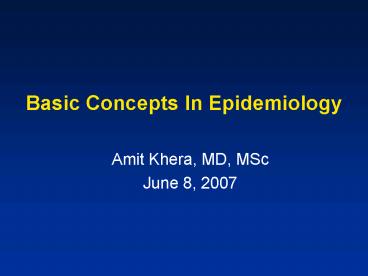Basic Concepts In Epidemiology PowerPoint PPT Presentation
1 / 28
Title: Basic Concepts In Epidemiology
1
Basic Concepts In Epidemiology
- Amit Khera, MD, MSc
- June 8, 2007
2
Epidemiology
- the study of the distribution and determinants
of disease frequency
MacMahon, B Epidemiology Principles and
Methods, 1970.
3
John Snow(1813-1858)
- Father of epidemiology
- London cholera epidemic of 1854
- Broad Street Pump
4
Epidemiology
- EXPOSURES
- determinants of disease
- (association)
- OUTCOMES
- endpoints of a study (disease)
5
Outcome Measures
- Prevalence proportion- proportion of a population
with the outcome (disease) at a single point in
time - Incidence- the number or proportion of
individuals developing the outcome (disease)
during a period of time - incidence proportion (risk)
- incidence rate
6
Obesity Among U.S. Adults 2002
No Data lt10 1014 1519
2024 25
Source Behavioral Risk Factor Surveillance
System, CDC
7
Lipid Levels and Heart Disease
12.50
11.91
11.91
14
9.05
10.7
11.24
12
6.6
10
14-year rates () for CHD
5.53
3.83
6.56
8
4.85
6
? 260
4.67
2.06
4.15
3.77
4
2.78
230259
2
200229
Total-C (mg/dL)
0
lt 200
lt 40
4049
5059
? 60
HDL-C (mg/dL)
Castelli WP et al. JAMA 198625628352838
8
Linking Exposures to Outcomes
- Outcome measures
- describe distribution of outcome
- Measures of Association
- quantify relationships to exposures
9
Measures of Association
- Difference Measures
- Risk Difference (absolute risk reduction)
- Incidence exposed - Incidence unexposed
10
NEJM 20043501495-1504
- 4162 subjects with acute coronary syndromes
- randomized to standard dose v. high dose statin
- therapy
- followed for mean of 24 months
- outcome- incidence of death, MI,
revascularization, - unstable angina, or stroke
Incidence of outcome in exposure group
22.4 Incidence of outcome in control group
26.3
--------- Risk Difference -3.9
11
Measures of Association
- Ratio Measures
- Risk Ratio
- Incidence Rate Ratio
- Hazard Ratio
- Odds Ratio
- Incidence exposed/Incidence unexposed
Relative Risk
12
NEJM 20043501495-1504
Incidence of outcome in exposure group
22.4 Incidence of outcome in control group
26.3
--------- Risk Ratio 0.85
(Relative Risk)
13
Are There Alternative Explanations?
- Measures of Validity
- Internal Validity
- Chance (p-value)
- Bias
- Confounding
- External Validity
- Generalizability
14
Bias
- Bias- systematic error affecting the results of
the study - Selection bias- association between disease and
exposure occurs because of the way participants
were selected, not by underlying truth - Recall bias- occurrence of outcome results in
increased recall of exposures - ex maternal recall bias
- Informational bias- differential
misclassification of exposure or outcome (MD
Behavior Bias)
15
Selection Bias
Question is congestive heart failure associated
with depression? CHF (exposure)? Depression
measured by questionnaire (outcome)
- STUDY A
- Patients in a cardiology clinic were approached
to be involved in the study - RR for depression in those with CHF 2.0
- STUDY B
- Patients were randomly selected from a
population-based study of CHF - RR for depression in those with CHF 1.2
16
Confounding
Confounding- mixing of the effect of an exposure
on the outcome with the effect of another
exposure Ex Downs Syndrome
Affected Babies/1000
Birth Order
17
External Validity
- Generalizability- how well do these results apply
to other populations? Ex Framingham Heart Study
Ten-Year Prediction of CHD Events in CMCS Men and
Women Using the Original Framingham Functions
Liu, J. et al. JAMA 20042912591-2599.
18
Study Types
- Observational
- cohort (follow-up)
- case-control
- cross-sectional (prevalence)
- Experimental
- randomized trial
19
Cohort Study
- Cohort study- study that follows or traces any
designated group over a period of time
Follow for outcome
Classify subjects by exposure
Benefits -less bias -can estimate population
rates of disease or exposure specific
risk Drawbacks -requires large population,
especially for rare outcome -can require long
follow-up period
20
JAMA 20042912448-2456.
- High-risk patients at an urban county hospital
- enrolled 190 cocaine exposed infants and 186
- non-exposed infants
- outcome Wechsler Preschool and Primary Scales
- of intelligence at 4 years
4 years
190 cocaine-exposed infants
outcome
186 non-exposed infants
4 years
outcome
RESULTS no difference in full-scale verbal or
performance IQ scores
21
Case-Control Study
Study in which subjects with the outcome (cases)
are compared to those without (controls) to
determine different exposure distribution
(usually retrospective)
Determine exposure
Classify subjects by outcome
Benefits -good for rare disease (outcomes), long
latency -requires fewer subjects than cohort
study Drawbacks -can introduce bias in selection
of controls -cannot estimate population rates of
disease or exposure specific risk
22
HMG-CoA Reductase Inhibitors and the Risk of Hip
Fractures in Elderly PatientsJAMA
20002833211-3216
- Reviewed histories from patients enrolled in New
Jersey Medicare or Medicaid or Pharmacy
Assistance for Aged and Disabled Program - 1222 patients who had a hip fracture
- 4888 control patients selected without hip
fracture (41- matched for age and sex)
1222 with hip fracture
exposure (statins)
4888 without fracture
exposure (statins)
RESULTS statin use 2.2 cases v. 4.4 controls
Odds Ratio of hip fracture with
statin use- 0.50
23
Cross-sectional Study
Study used to assess the prevalence of disease at
one point in time
JACC 2004431791-1796
24
Randomized Controlled Trial
- Type of cohort study in which the exposures are
assigned - Gold standard for epidemiologic trials
- Randomization ensures equal distribution of
confounders
25
1. Randomization
2. Assign Exposure
Gender known confounder
unknown confounder
26
24 months
Low-dose statin
Outcome
26.3
Subjects with ACS
High-dose statin
24 months
Outcome
22.4
Randomized (Exposure Assigned)
27
Suggested Reading
- Rothman K.J. Epidemiology An Introduction, New
York Oxford University Press, 2002. - Hennekens CH, Buring JE. Epidemiology in
Medicine, Boston Little, Brown and Co., 1987
28
(No Transcript)

